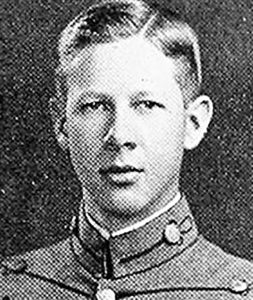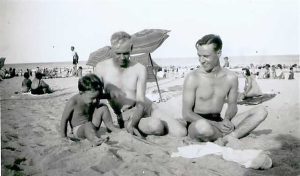Before we begin our next installment of the Patrick County defenders of Bataan, we need to reintroduce the subjects of our story. These first few paragraphs are a repeat of the introduction from last week. When we left off last week, General Wainwright had surrendered all American forces in Bataan on April 9th, 1942.
Camden Ross Bryant (1916-1944) was born to Homer Orlando Bryant and Martha Magdaline Via Bryant. Camden’s paternal grandfather was Reverend Alexander Bryant, founder of Fairview and Rock Castle Church and pastor of Sycamore Baptist Church for many years, and grandmother, Sarah Jane Ross Bryant. Camden’s maternal grandparents were Peter Lee Via and Dicey Elizabeth King Via from the Dodson community of Patrick County.

2nd Lt. Reid “Stanley” Aaron (1918-1945) was born to John Reid Aaron and Jessie Stanley Aaron of Martinsville. Stanley was the nephew of Virginia Governor Thomas Bahnson Stanley, Sr. and Stanley’s brother, Jacob Crockett Aaron married Camden Bryant’s sister, Era Marie Bryant in 1948.
James Walter Trent (1919-1963) grew up in the area between Patrick Springs and Critz. James was the son of Walter Cole Trent and Nannie Virginia Witt Trent, the paternal grandson of Abe Trent and Nancy Spencer Trent, and the maternal grandson of Charles Richard Witt and Nancy Reynolds Witt of the Carter’s Store area of Henry County.
Ralph Jefferson Turner, Sr. (1922-1990) was born at Buffalo Ridge, Virginia to Abram Columbus Turner and Allie Walker Turner. Ralph was the paternal grandson of John Francis Turner and Nancy Adeline Nolen Turner and the maternal grandson of James Lincoln Walker and Mary Bowling Walker of the Elamsville district of Patrick County.
In 1940, Hayne Wesley Dominick, Jr. (1920-1995) was working as a car salesman at Burrough-White Chevrolet in Martinsville. In 1946, Hayne married Betty Ruth Critz, the daughter of William Russell Critz and Anna Ruth Tatum of Nettle Ridge. In November of 1945, Sgt. Hayne Dominick related his experiences in WWII to Kay Thompson who recorded them in chapter form. Thompson submitted them to the War Department, and they were released for publication in the Martinsville Bulletin. For the next few weeks, we will look at excerpts from Hayne’s account where he describes time spent with our Patrick (and Henry) County boys.
Chapter Four, published on November 24th, 1945, Hayne recalled, “Just before the surrender, I contracted malaria on April 3rd, and my temperature went to the unbelievable high of 106.2 degrees. We hung on to the hope that General MacArthur had left the Philippines for Australia on orders of President Roosevelt and that he was going there to gather a mighty sea armada and thousands of troops and guns, tanks and planes for the immediate rescue of our beleaguered forces. We were told that we must hold Bataan no matter what the cost…Despite being greatly outnumbered and expected to outmaneuver an experienced army trained since they were children, the thought of surrender hadn’t even remotely been part of our thinking. I am certain if any man in Bataan had known what was in store for him, he would have never laid down his arms. Camden and I discussed if people back home would think that we fought hard enough.”
Hayne recalled, “For six days, and way into the night, these cruel Japanese soldiers marched us without food-150 miles of tortuous footsteps, staggering, stumbling, pushing, grumbling, and wishing at each step for a cool drink of water or a bite of food. We averaged 25 miles a day without one bite of food to eat; occasionally they would allow us to drink from creeks, ditches, or mud puddles. One night they marched us to 10pm and then woke us up at 3am and ordered us on our dismal way. Camden and I were together the first three days of the march, but one night, they herded us into a field, and under the cover of darkness, we got separated…. The thirst drove many men crazy, and I witnessed one man shot to death for attempting to get this necessity of life. In the six days of the march, I witnessed at least twenty men get bayoneted and left to die in ditches by the side of the road, including the beheading of one young Filipino solider.”
Chapter Five, published on November 26th, 1945, Hayne begins, “On April 16th, we were given the first food we had since April 9th, (before the Death March). It was a bowl of rice, provided by the Filipinos. We were loaded aboard a train, 100 men to a box car, and headed toward Camp O’Donnell… Five days after arriving at the camp, I saw 2nd Lt. Stanley Aaron and a few hours later, I saw Camden Bryant. All three of us were in bad shape physically, losing about 40 pounds apiece by the time we arrived at camp. Camden and Stanley both had malaria by that time too.”
Hayne stated, “Camden and I volunteered for burial detail, and we buried at least 100 American boys in a cemetery beyond the prison gates. We walked out each morning under guard and dug the graves-7 feet wide and 12 feet long. About 20 men were put into each grave, which could be dug no deeper than three feet because of the marshy terrain. If we dug deeper, we buried our buddies in water.” For the 8,000 Americans imprisoned at Camp O’Donnell, there was one water tap. Men stood in line for three to five hours to get one canteen of water. One day, I was the 10th man from the tap when the Japanese cut the water off for the day. By the time I learned that I was being sent to Camp Cabanatuan, my weight had dropped to 110 pounds. Camden had already been sent out on a bridge building detail, leaving three days ahead of me. I hated to leave Stanley, but I had no choice, I had to go.”
Chapter Six, published on November 27th, 1945, Hayne recalled, “After arriving at Camp Cabanatuan, I volunteered for burial detail again and we were burying 30 to 50 American boys per day. Camden and Stanley arrived at the camp within one week of each other and being together again was a boost to the morale of each of us. We swapped stories, planned for the future, and talked about going home.”
Hayne, “I became ill with cerebral malaria on June 20th, 1942. I was unconscious or semi-conscious for two weeks and didn’t recognize anyone from my outfit, or Stanley or Camden, as they visited me when they could slip away. An American doctor managed to hide some quinine and administered it to me…. In April of 1943, I was struck down with beriberi of the cardiac. Camden and Stanley came to see me about once each week…About two months after coming into camp, the Japanese put Camden to work cutting hair, even the Japanese soldiers’ hair…Under the Geneva Convention, officers did not have to work, but 2nd Lt. Stanley Aaron volunteered to work on farm detail. These men went into the fields at daybreak, worked until dark, and watched the cucumbers, peppers, and sweet potatoes they had planted grow into full maturity. The Japanese had the soldiers load the harvest onto trucks and carry it away to market, without getting to eat any of what they had grown.”

I recently had the honor and privilege of learning more about Camden Bryant from his sister, Darlene Thielman, and his niece, Sandy Taylor. Sandy shared the following childhood memories of her Uncle Camden, “I was only 3 or 4 years old at the time and not entirely sure of what was happening. However, I clearly recall seeing the family (my parents, grandfather and aunt) rush each afternoon to retrieve the Martinsville Bulletin and pour over the war news. I knew something serious and bad was happening because I saw how distressed they were. Once, they were preparing a package on the kitchen table to send to Cam who was in a Japanese POW camp. They worried about the items they were sending, fearing that if it was questionable, his captors might not let him have the box. They said, ‘Should we put this in?’ and ‘I wonder if they would let him have this?’ When it was finally wrapped up in brown paper, I put my finger on the twine while my dad tied the knots. We never knew whether or not he got the packages, but we did receive a couple of POW cards from Cam in which he tried to reassure us that he was okay. Later, when we learned that Cam had died, I knew that something really terrible and life-changing had happened. When we were older, my cousin Sammy Frazier and I often talked about our Uncle Cam. We liked to imagine that he had escaped and was living happily on a tropical island! But we knew it wasn’t true. I still feel the grief of this loss and believe it was a major event in my young life. I even wrote a poem about that idea many years ago!”
Next week, we will meet the other two Patrick County soldiers at camp, James Walter Trent and Ralph Jefferson Turner, Sr. Thank you so much to Darlene Thielman and Sandy Taylor for sharing precious memories of Camden. Woody may be reached at rockcastlecreek1@gmail.com or 276-692-9626.




